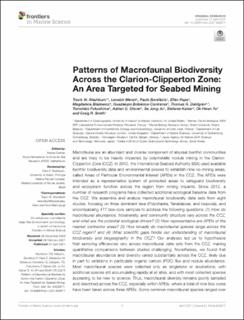| dc.contributor.author | Washburn, Travis | |
| dc.contributor.author | Menot, Lenaick | |
| dc.contributor.author | Bonifácio, Paulo | |
| dc.contributor.author | Pape, Ellen | |
| dc.contributor.author | Blazewicz, Magdalena | |
| dc.contributor.author | Bribiesca-Contreras, Lupita | |
| dc.contributor.author | Dahlgren, Thomas Gunnar | |
| dc.contributor.author | Fukushima, Tomohiko | |
| dc.contributor.author | Glover, Adrian G. | |
| dc.contributor.author | Jung Ju, Se | |
| dc.contributor.author | Kaiser, Stefanie | |
| dc.contributor.author | Hwan Yu, Ok | |
| dc.contributor.author | Smith, Craig R. | |
| dc.date.accessioned | 2021-09-24T07:35:31Z | |
| dc.date.available | 2021-09-24T07:35:31Z | |
| dc.date.created | 2021-04-16T14:03:33Z | |
| dc.date.issued | 2021 | |
| dc.identifier.citation | Frontiers in Marine Science. 2021, 8 1-22. | en_US |
| dc.identifier.issn | 2296-7745 | |
| dc.identifier.uri | https://hdl.handle.net/11250/2781292 | |
| dc.description.abstract | Macrofauna are an abundant and diverse component of abyssal benthic communities and are likely to be heavily impacted by polymetallic nodule mining in the Clarion-Clipperton Zone (CCZ). In 2012, the International Seabed Authority (ISA) used available benthic biodiversity data and environmental proxies to establish nine no-mining areas, called Areas of Particular Environmental Interest (APEIs) in the CCZ. The APEIs were intended as a representative system of protected areas to safeguard biodiversity and ecosystem function across the region from mining impacts. Since 2012, a number of research programs have collected additional ecological baseline data from the CCZ. We assemble and analyze macrofaunal biodiversity data sets from eight studies, focusing on three dominant taxa (Polychaeta, Tanaidacea, and Isopoda), and encompassing 477 box-core samples to address the following questions: (1) How do macrofaunal abundance, biodiversity, and community structure vary across the CCZ, and what are the potential ecological drivers? (2) How representative are APEIs of the nearest contractor areas? (3) How broadly do macrofaunal species range across the CCZ region? and (4) What scientific gaps hinder our understanding of macrofaunal biodiversity and biogeography in the CCZ? Our analyses led us to hypothesize that sampling efficiencies vary across macrofaunal data sets from the CCZ, making quantitative comparisons between studies challenging. Nonetheless, we found that macrofaunal abundance and diversity varied substantially across the CCZ, likely due in part to variations in particulate organic carbon (POC) flux and nodule abundance. Most macrofaunal species were collected only as singletons or doubletons, with additional species still accumulating rapidly at all sites, and with most collected species appearing to be new to science. Thus, macrofaunal diversity remains poorly sampled and described across the CCZ, especially within APEIs, where a total of nine box cores have been taken across three APEIs. Some common macrofaunal species ranged over 600–3000 km, while other locally abundant species were collected across ≤ 200 km. The vast majority of macrofaunal species are rare, have been collected only at single sites, and may have restricted ranges. Major impediments to understanding baseline conditions of macrofaunal biodiversity across the CCZ include: (1) limited taxonomic description and/or barcoding of the diverse macrofauna, (2) inadequate sampling in most of the CCZ, especially within APEIs, and (3) lack of consistent sampling protocols and efficiencies. | |
| dc.language.iso | eng | en_US |
| dc.rights | Navngivelse 4.0 Internasjonal | * |
| dc.rights.uri | http://creativecommons.org/licenses/by/4.0/deed.no | * |
| dc.title | Patterns of Macrofaunal Biodiversity Across the Clarion-Clipperton Zone: An Area Targeted for Seabed Mining | en_US |
| dc.type | Peer reviewed | en_US |
| dc.type | Journal article | en_US |
| dc.rights.holder | © 2021, Washburn, Menot, Bonifácio, Pape, Błazewicz, Bribiesca-Contreras, Dahlgren, Fukushima, Glover, Ju, Kaiser, Yu and Smith | |
| dc.description.version | publishedVersion | |
| cristin.ispublished | true | |
| cristin.fulltext | original | |
| cristin.qualitycode | 1 | |
| dc.identifier.doi | 10.3389/fmars.2021.626571 | |
| dc.identifier.cristin | 1904612 | |
| dc.source.journal | Frontiers in Marine Science | en_US |
| dc.source.volume | 8 | en_US |
| dc.source.pagenumber | 1-22 | en_US |
| dc.relation.project | Norges forskningsråd: 290931 | |

